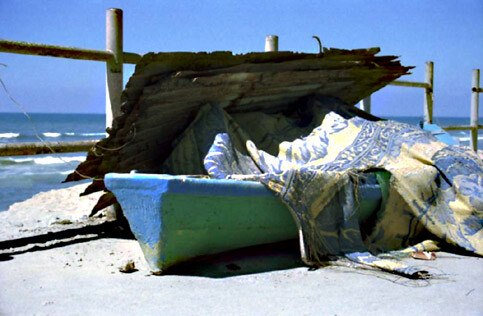World Food Programme 6 October 2004

Many Gazans have traditionally depended on the sea for their livelihood. Of the estimated 1.3 million people living on the Strip, some 40,000 live off fishing. (Helga Tawil)
GAZA — Cooked with tomatoes and spices, Gaza shrimps, like those Laid Sad and his sons used to fish, are a delicacy in the Middle East. Most of the Sad family’s catch was sent to Israel and neighboring countries, where it fetched a high price.
Many Gazans have traditionally depended on the sea for their livelihood. Of the estimated 1.3 million people living on the Strip, some 40,000 live off fishing. But Israeli restrictions on the movement of Palestinian fishermen over the past three years have left many destitute, including Sad.
Since 2002, Gaza fishermen have been banned from going beyond six nautical miles from the shoreline. There have been long periods when that distance was cut in half and in southern areas of Gaza , like the cities of Rafah and Khan Younis, fishing has frequently been totally banned.
From 2001-2003 fishermen in these two large fishing communities were grounded for 600 days. The reason is Israeli security but the consequence for the fishermen is devastating.
Too costly to fish
Even if they can go out to sea, they often don’t. Sad has not fished in two months. “It’s too costly, especially if we don’t catch anything,” he says, as he sits on the beach with his two sons and repairs the green nets he hopes he can use next season.
Unused green wooden skiffs dot the beaches along the 42-kilometer Gaza coastline, located on the southeastern part of the Mediterranean Sea. Some are now buried under the sand. Having lost their capacity to fish since the second Intifada, most of these fishermen have seen their incomes drop by 70 percent.
The limited access also means that the restricted areas are now largely over-fished, leading to a dramatic decrease in the quantity and quality of fish caught. Shrimps have completely disappeared. These days, sardines are the main catch but they bring in little revenue.
Sad’s income has dropped from 30,000 shekels (US$6,667) a year to 6,000 shekels (US$1,333) a year and they are not allowed to export the fish.
Market hungry
“The market is hungry for fish but the amount of fish caught is not enough to feed the people,” explains Finn Ebbesen of the Danish International Development Assistance (DANIDA), which has been working in Gaza for almost a decade.
And there are more people to feed. The number of fishermen on the Strip has mushroomed following the ban on Palestinians working in Israel. Those who returned to Gaza hoping to find work in the industry instead found themselves unemployed.
“This is a category of people who have lost everything and are very food insecure,” warns Jean-Luc Siblot, who heads WFP’s operations in the Palestinian Territories.
Conflict victims
To help the fishermen cope, WFP along with its implementing partner, DANIDA, started Food-for-Work and Food-for-Training projects to support some 1,470 fishermen households, or 8,820 people who have been most affected by the ongoing conflict.
“What is most important is for households to find other ways to make a living which will cushion them against the effects of the humanitarian crisis they are facing,” explains Siblot. “By providing food aid, WFP is trying to help them do this.”
In exchange for maintaining the upkeep of their boats and nets, the Gazan fishermen are given monthly WFP food rations of wheat flour, sugar, olive oil and lentils. “This has helped us to stay alive,” says Sad.
Female illiteracy
While the fishermen tend their nets, their wives are also benefiting from WFP’s assistance. In December 2003 WFP and DANIDA introduced a food-for-training project for these women in an effort to help them to cope with the deteriorating social and economic situation in Gaza. Many of the 1,200 women targeted are illiterate and unskilled.
In exchange for attending 12 hours of courses in literacy, law and healthcare every month, they get a monthly food ration.
Six months into the course, most say they would continue the classes even without the food. “In the past we were only cooking but now we know how to read,” says one participant.
Partners in poverty
“The project has gone beyond my wildest dreams,” said Ebbesen. “With training, these women can take more active responsibility for their lives and seize future opportunities.”
Slogans on the walls of the school, such as “Moving Towards a Better Future” and “We Are Partners in Poverty, We Should be Partners in the Decision-making Process” underline the determination the women feel to improve their lives. “The value of the training is ultimately more than the value of the food,” explains Ebbesen.
Israeli disengagement
The Gazan fishermen and their families are among the 480,000 people WFP is assisting in the Palestinian Territories. Over the past six months, the UN agency has transported and distributed 24,000 metric tons of food in the Territories and plans to distribute over 78,400 metric tons of food commodities over the next year.
Israel ‘s ‘disengagement plan’ in Gaza , expected to go into effect in 2005, could improve the conditions for WFP beneficiaries like the Gazan fishermen. According to a recent World Bank study, the key to the prosperity of the Palestinian economy is the economic relationship with Israel.
For the fishermen and their families, a pullout both on land and sea is fundamental if the local economy is to thrive and Gaza shrimps can come back on to tables in the Middle East.
Related Links